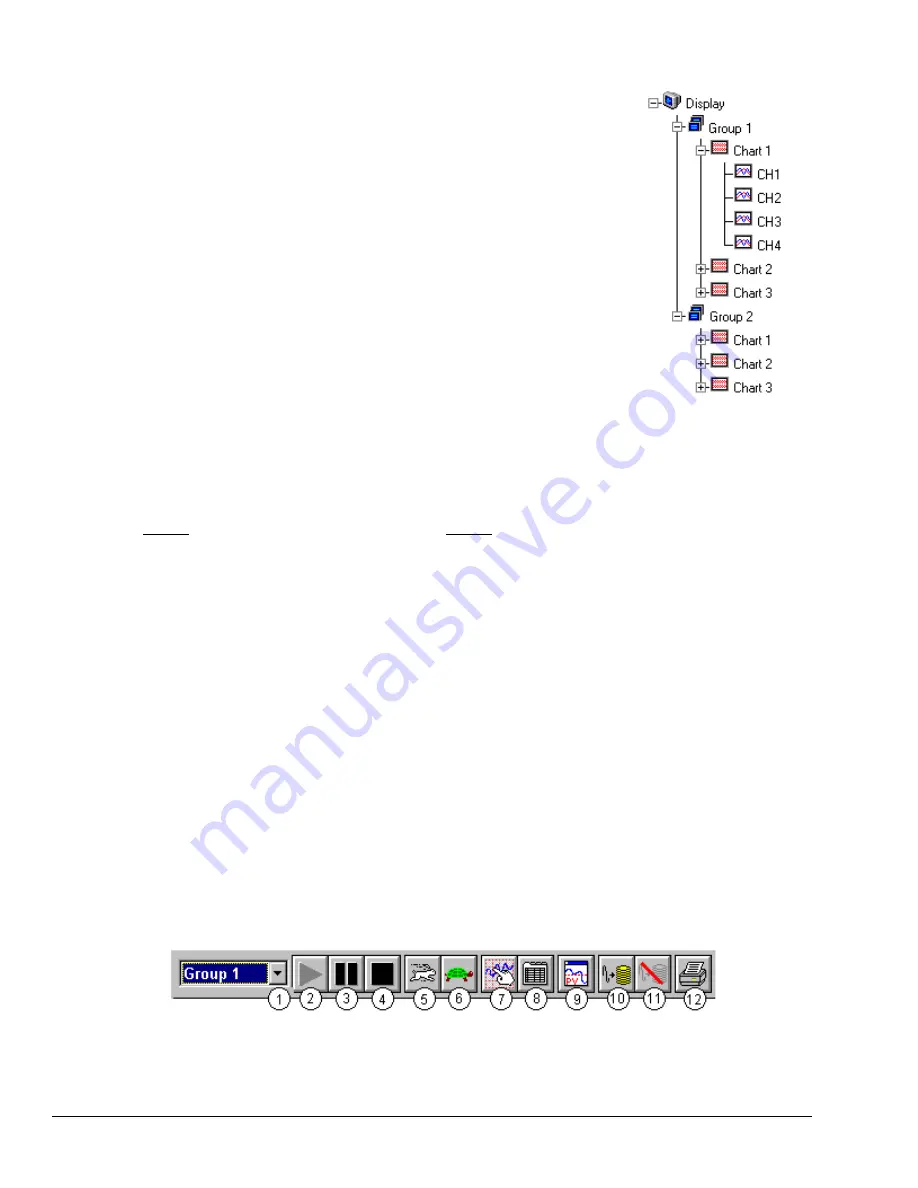
2-8 ChartView Quick Start and Tutorial
NetScan User’s Manual
Note:
Once your chart setup is complete you can always go back and edit
the setup.
For the purpose of our tutorial, complete the following steps. Note that these steps
are catered to ChartView Plus. Comments regarding standard ChartView are
presented in brackets [ ].
◊
(5) Verify that the Advanced tab (under Automatic Chart Creation) is selected.
[Simple must be used for standard program].
◊
(6) Choose “2” for the number of groups. [Standard program is limited to 1 group].
◊
(7) Choose “3” for the number of charts.
◊
(8) Choose “4” for the number of channels.
◊
(9) Click Automatic Chart Creations/Create Charts. At this point your chart
appears on the Main Window.
◊
(10) Click on the Display Configuration button (item 7, see toolbar figure, below).
Though you usually won’t do this at this point, this act permits you to see a
representation of your configuration, and permits you to make changes.
You should end up with a configuration display of two groups, each with 3 charts, and each chart with 4 channels
[for standard ChartView users the display will be for 1 group only].
Because Automatic Chart Creation was chosen (starting with Channel 1) for ChartView Plus users, the Channel
arrangement was automatically assigned as follows:
Group 1
Group 2
Chart 1
CH1, CH2, CH3, CH4
Chart 1
CH13, CH14, CH15, CH16
Chart 2
CH5, CH6, CH7, CH8
Chart 2
CH17, CH18, CH19, CH20
Chart 3
CH9, CH10, CH11, CH12
Chart 3
CH21, CH22, CH23, CH24
By using the mouse arrow and clicking on a Group, Chart, or Channel you will alter the appearance of the
display, but not alter its actual configuration. For example, in the previous Display tree figure we see channels 1
through 4 assigned to Chart 1 of the first Group.
◊
(11) ChartView Plus users: click on the word/number “Group 2.”
◊
(12) ChartView Plus users: click on the word/number “Chart 3” (of Group 2). You should now see channels
21 through 24 listed at that location.
The channels in the setup you just created will be automatically enabled and will appear in chart form
on ChartView’s Main Window. The Channels will overlap on their assigned Chart, and will be
visible when the applicable Group is selected. Note that only one group of charts can be viewed at a
time, even if you are using ChartView Plus.
You can enable additional channels from the Channel Configuration window. This allows you to
acquire more data; however, it will not change your display on ChartView’s Main Window. In other
words, you can acquire data from channels which you do not monitor.
◊
(13) Click “Okay” to exit the dialog box.
1- Group
Select
2-
Start Charts & Indicators
3- Pause
Charts
4- Stop
Charts
5- Scroll
Faster
6-
Scroll Slower
7- Display
Configuration
8- Channel
Configuration
9- PostView
10- Arm
Acquisition
11- Disarm
12-
Print Charts
Summary of Contents for OMB-NETSCAN 1500
Page 6: ...iv NetScan User s Manual...
Page 18: ...1 12 Configuring and Starting NetScan NetScan User s Manual Notes...
Page 38: ...3 8 General Information and Specifications NetScan User s Manual Notes...
Page 82: ...4 44 ChartView Software Reference NetScan User s Manual Notes...
Page 118: ...6 20 Calibration NetScan User s Manual...
Page 140: ...A ii NetScan User s Manual...
Page 192: ...API Command Reference Appendix A A 52 NetScan User s Manual Notes...
Page 237: ...Appendix D Registers Data Formats Queries NetScan User s Manual D 13...
Page 244: ...NetScan Program Examples Appendix E E 2 NetScan User s Manual...
Page 248: ...ASCII Code Summary Appendix F F 4 NetScan User s Manual Notes...
Page 250: ...NetScan Error Messages Appendix G G 2 NetScan User s Manual Notes...
Page 252: ...Abbreviations Appendix H H 2 NetScan User s Manual Notes...
Page 254: ...NetScan User s Manual...
















































